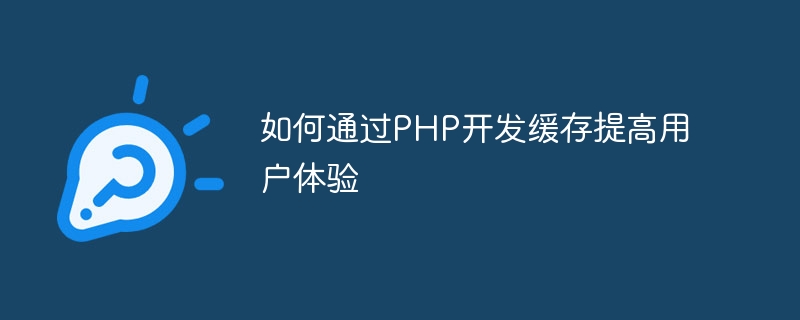

How to improve user experience through PHP cache development
With the rapid development of the Internet, user experience has become a crucial part of website development. For PHP developers, an effective caching strategy can improve website performance and user experience. Through caching, you can reduce the number of database accesses, reduce server load, speed up page loading, etc. This article will introduce how to develop cache through PHP, methods to improve user experience, and specific code examples.
1. File system-based caching
File system caching is one of the simplest caching methods. The data is serialized and stored in a file, and then the data is read from the file. Deserialize. Since file IO operations are slow, it is generally suitable for small data caches. The specific code is as follows:
<?php
function get_data_from_cache($key) {
$filename = "/tmp/" . md5($key) . ".cache";
if (file_exists($filename)) {
$file_content = file_get_contents($filename);
$data = unserialize($file_content);
if ($data['exp_time'] > time()) {
return $data['value'];
} else {
unlink($filename);
}
}
return null;
}
function set_data_to_cache($key, $value, $exp_time = 3600) {
$filename = "/tmp/" . md5($key) . ".cache";
$data = [
'exp_time' => time() + $exp_time,
'value' => $value,
];
$file_content = serialize($data);
file_put_contents($filename, $file_content);
}
?>2. Memory-based caching
Different from file system-based caching, memory-based caching stores data in memory and has faster reading and writing speeds. Commonly used PHP memory caches include Memcache and Redis. The specific code is as follows:
<?php
$memcache = new Memcache();
$memcache->connect("127.0.0.1", 11211) or die ("Could not connect");
// 从缓存中获取数据
function get_data_from_memcache($key) {
global $memcache;
$data = $memcache->get(md5($key));
return $data ? $data : null;
}
// 将数据写入缓存
function set_data_to_memcache($key, $value, $exp_time = 3600) {
global $memcache;
$memcache->set(md5($key), $value, false, $exp_time);
}
?><?php
$redis = new Redis();
$redis->connect('127.0.0.1', 6379);
$redis->auth('password');
// 从缓存中获取数据
function get_data_from_redis($key) {
global $redis;
$data = $redis->get(md5($key));
return $data ? $data : null;
}
// 将数据写入缓存
function set_data_to_redis($key, $value, $exp_time = 3600) {
global $redis;
$redis->set(md5($key), $value, $exp_time);
}
?>3. Framework-based cache
Most PHP frameworks have built-in cache components. Using the cache components of the framework can more conveniently perform cache read and write management. The following takes the Laravel framework as an example to introduce how to use Laravel's caching component.
Use Composer to install the Laravel framework:
composer create-project --prefer-dist laravel/laravel blog
Open.env file, set the cache driver to Redis:
CACHE_DRIVER=redis
At the same time, add the Redis configuration in the config/database.php file:
...
'redis' => [
'client' => 'predis',
'default' => [
'host' => env('REDIS_HOST', '127.0.0.1'),
'password' => env('REDIS_PASSWORD', null),
'port' => env('REDIS_PORT', 6379),
'database' => 0,
],
],
...In the Laravel framework, you can use the Cache class to access the cache component. The sample code is as follows:
<?php
use IlluminateSupportFacadesCache;
// 从缓存中获取数据
function get_data_from_laravel_cache($key) {
return Cache::get(md5($key));
}
// 将数据写入缓存
function set_data_to_laravel_cache($key, $value, $exp_time = 3600) {
Cache::put(md5($key), $value, $exp_time);
}
?>Through the above code examples, we can learn how to develop cache through PHP to improve user experience. By storing data in the cache, multiple accesses to the database can be avoided, greatly speeding up response and improving user experience. At the same time, by using various types of cache, we can adapt to different application scenarios. For example, small caches can use file system cache, and larger caches can choose memory cache or frame cache.
It should be noted that when using cache, you need to pay attention to the setting of cache expiration time to avoid expired use of data. At the same time, you also need to pay attention to the cache clearing and updating mechanism to avoid data inconsistency.
The above is the detailed content of How to improve user experience with PHP cache development. For more information, please follow other related articles on the PHP Chinese website!
 Features of ruby language
Features of ruby language
 What to do if the web page cannot be accessed
What to do if the web page cannot be accessed
 How to add css style to html
How to add css style to html
 Why is my phone not turned off but when someone calls me it prompts me to turn it off?
Why is my phone not turned off but when someone calls me it prompts me to turn it off?
 Detailed process of upgrading win7 system to win10 system
Detailed process of upgrading win7 system to win10 system
 How to open csv format file
How to open csv format file
 The difference between threads and processes
The difference between threads and processes
 Delete exif information
Delete exif information